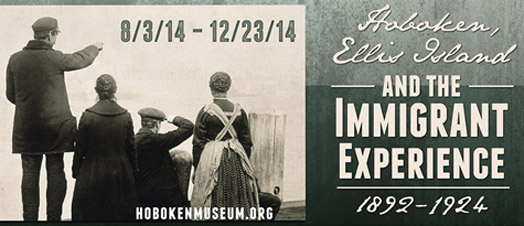Hoboken, Ellis Island, and the Immigrant Experience, 1892-1924
August 3, 2014 – December 23, 2014

Click here to take an interactive virtual tour of the exhibit.
If Hoboken seems crowded today, with a population just over 50,000, imagine how crowded it was between 1892 – 1924, the peak period of U.S. immigration. Following the Immigration Act of 1891, which established federal control over immigration, Hoboken’s—and the entire country’s—demographics changed dramatically. During the next three decades, 20 million people immigrated to the United States, and more than half, 12 million, passed through the New York and Hoboken.
Hoboken became renowned across the world as “the port of entry to a continent,” according to Daniel Van Winkle’s history of Hudson County, published in 1924. Hoboken’s population swelled from 43,648 in 1890 to 70,324 in 1910 with the surge in European immigration, which was fueled in part by the major passenger shipping lines that docked here, including Hamburg-America Packet Company, North German Lloyd Steamship Company, Scandinavian-American Line, and Holland America Line.
The Hoboken Historical Museum examined this period in a new exhibit, “Hoboken, Ellis Island, and the Immigrant Experience, 1892-1924,” which opened Sunday, Aug. 3. Guest curator Dr. Christina Ziegler-McPherson, an immigration historian who lives in Hoboken, brought to life through images, artifacts, and oral histories the experience of immigrants who passed through Ellis Island and Hoboken during the peak years of U.S. immigration. A companion lecture series, “The Immigrant Experience,” brought noted scholars and authors to the Museum to expand on the topic.
Immigration Transformed Hoboken
In addition to descendants of Dutch and English settlers, German and Irish immigrants had largely shaped Hoboken in the mid- to late 19th century. In 1890, 40 percent of Hoboken’s population of 43,648 was foreign-born—and the majority of the city’s native-born residents had parents born in Germany or Ireland. Only 790 Italian immigrants lived in Hoboken in 1890.
Just two decades later, in 1910, Germans and German-Americans continued to dominate Hoboken, but for the first time, the city had more Italian and Italian-American residents than Irish and Irish-Americans. Hoboken also had a growing number of residents born in Russia, Austria, and Norway.
The exhibition also offered an in-depth look at the conditions immigrants faced before leaving their ports of embarkation, and the class divides on board between first and second class and steerage. The treatment received on arrival in New York Harbor differed by passenger class, too, with the steerage passengers diverted to Ellis Island for screening, while first and second class passengers simply disembarked in Hoboken or New York after an on-board health check, and then were free to go. The exhibit ran through December 23.

